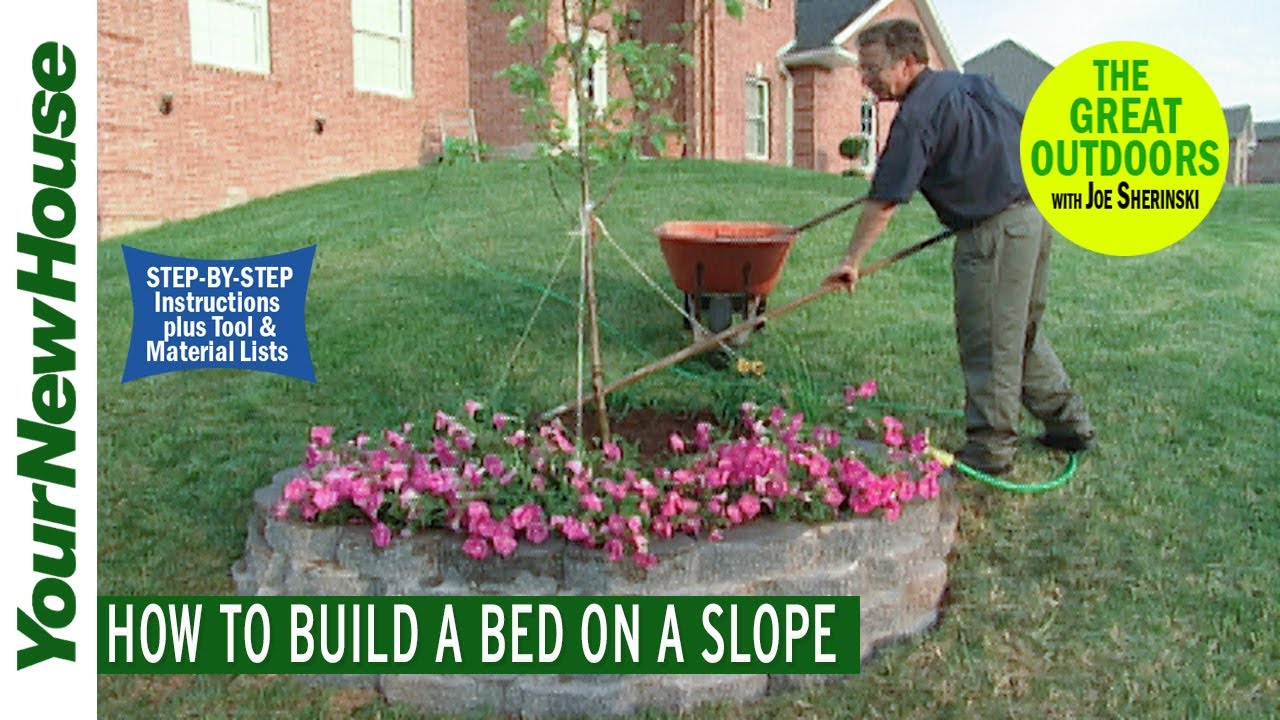To build a stone flower bed on a slope, start by leveling the ground and laying a solid base. Then, arrange the stones in a staggered pattern, ensuring they are securely placed.
A stone flower bed on a slope adds beauty and functionality to your landscaping, creating an attractive focal point in your garden. By following these steps, you can build a sturdy and visually appealing flower bed that will last for years to come.
With a little planning and effort, you can transform a sloping area into a charming space to showcase your favorite flowers and plants.

Credit: conniecavanaugh.net
Assessing The Slope And Choosing The Location
Building a stone flower bed on a slope can be a challenging yet rewarding project. Not only does it add a unique touch to your garden, but it also allows for better drainage and aesthetic appeal. Before you begin, it’s crucial to assess the slope and choose the perfect location for your stone flower bed.
In this section, we will discuss the important factors to consider to ensure a successful construction.
Consider The Slope Gradient And Orientation For Optimal Sunlight Exposure
When building a stone flower bed on a slope, it’s crucial to take into account the slope gradient and orientation to optimize sunlight exposure. Here are a few key points to keep in mind:
- Determine the direction of the slope to understand how sunlight will affect the flower bed throughout the day.
- Choose a location that receives the ideal amount of sunlight for the flowers and plants you plan to grow.
- Note the shaded areas created by nearby structures or trees and select a location that minimizes these shadows.
- If the slope faces south, it will receive more sunlight, making it suitable for sun-loving plants. North-facing slopes, on the other hand, may have more shade.
Determine If Any Drainage Issues Need To Be Addressed
Proper drainage is essential for the health and longevity of your stone flower bed. Here are a few things to consider:
- Assess the current drainage conditions of the slope to determine if any issues need to be addressed. Look for signs of water pooling or erosion.
- If the slope has poor drainage, you may need to make adjustments by adding drainage pipes or creating channels for water to flow away from the flower bed.
- Consider the soil type on the slope. If it is heavy clay soil, it may retain water and require additional measures, such as adding organic matter or installing a drainage system.
Look For A Level Surface Or Create Terraces For Stability
A stable and level surface is essential for the longevity of your stone flower bed. Here’s what you need to know:
- Look for a relatively level area on the slope where you plan to build the flower bed. This will make the construction process easier and ensure stability.
- If the slope is too steep or uneven, consider creating terraces. Terracing involves building multiple flat areas on the slope, providing stability for the stone flower bed.
- To create terraces, you can build retaining walls using stones, bricks, or other suitable materials. These walls not only add stability but also enhance the aesthetic appeal of your flower bed.
By assessing the slope gradient and orientation, addressing drainage issues, and ensuring stability through level surfaces or terraces, you’re setting a solid foundation for your stone flower bed. In the next section, we will delve into the steps required to prepare the slope and construct the flower bed.
Stay tuned for more insights and tips on bringing your stone flower bed to life!
Preparing The Ground And Gathering Materials
Clear The Area Of Any Vegetation And Debris
Before beginning to build a stone flower bed on a slope, it’s essential to clear the area of any vegetation and debris. This step ensures a clean and stable foundation for your flower bed. Here’s how to get started:
- Remove any plants, grass, or weeds in the designated area. Use a garden rake or shovel to loosen the soil and easily uproot the vegetation.
- Dispose of the cleared vegetation and debris properly. Composting or recycling are environmentally friendly options.
- Check the area for any rocks, branches, or other objects that could interfere with the construction of the flower bed. Remove them to create a smooth surface.
Dig Trenches To Mark The Shape And Dimensions Of The Flower Bed
To create a defined shape and ensure proper dimensions for your stone flower bed on a slope, it’s crucial to dig trenches. This will serve as a guide for placing the stones and give your flower bed structure. Follow these steps:
- Use a shovel or garden edger to dig trenches along the edges of your desired flower bed shape. The depth of the trenches should match the thickness of the stone you plan to use.
- Use a measuring tape to ensure the trenches are of the desired length and width. This will help you maintain consistency throughout the bed.
- Make sure the trenches are level and even around the entire perimeter of the flower bed. Use a spirit level to check for any slopes or gaps that need adjustment.
Gather stones of various sizes, gravel, landscape fabric, and soil amendments
The materials you gather for your stone flower bed will determine its durability and aesthetic appeal. Collect the following items before starting the construction:
- Stones: Look for stones of various sizes and shapes to create a natural and visually appealing look. Choose stones that suit your design preference and match the surrounding landscape. Aim for a mix of larger boulders and smaller stones.
- Gravel: Gravel acts as a drainage layer and helps prevent water from pooling in your flower bed. Choose a suitable size of gravel that allows water to flow through easily.
- Landscape fabric: Use landscape fabric to create a barrier between the soil and the stones. This will help control weed growth and prevent soil erosion.
- Soil amendments: Depending on the type of plants you intend to grow in your flower bed, consider adding soil amendments such as compost or organic matter. This will enrich the soil and provide essential nutrients for healthy plant growth.
By following these steps and gathering the necessary materials, you’ll be well on your way to building a beautiful and functional stone flower bed on a slope.
Building The Stone Flower Bed
Laying the first row of stones along the trench:
- Start by digging a trench along the slope where you want to build the stone flower bed.
- Place the first row of stones along the trench, ensuring they are level and properly aligned.
- Use a level to check that the stones are even and adjust as necessary.
- The first row serves as the foundation for the rest of the stone flower bed, so it is important to get it right.
Ensure proper leveling and adjust as necessary:
- Take the time to ensure that each stone in the row is level and aligned with the others.
- Use a leveler to check the horizontal position of each stone.
- Make adjustments as necessary, adding or removing soil beneath the stones to achieve the desired level.
- Proper leveling is essential for the stability and aesthetics of the stone flower bed.
Continuing stacking stones, interlocking them for stability:
- Once the first row is in place and leveled, continue building the stone flower bed by stacking more stones on top.
- Interlock the stones by positioning each one so that it overlaps the joints between the stones in the row below.
- This interlocking technique adds stability to the flower bed and prevents the stones from shifting over time.
- Be mindful of the pattern you create, ensuring a visually appealing and structurally sound result.
Filling the gaps between stones with smaller rocks and gravel:
- After stacking the stones, you will notice gaps between them.
- Fill these gaps with smaller rocks and gravel, ensuring to pack them tightly for stability.
- The smaller rocks and gravel help to hold the larger stones in place, preventing them from shifting or collapsing.
- Take care to fill all gaps, creating a solid and cohesive stone flower bed.
Creating a beautiful stone flower bed on a slope requires careful planning and execution. By following these steps, you can ensure that your flower bed is not only visually pleasing but also structurally sound for years to come.
Enhancing Stability And Drainage
Building a stone flower bed on a slope can be quite a challenge, but with the right techniques, you can create a stunning landscape that not only enhances the beauty of your garden but also improves stability and drainage. In this section, we will discuss two essential aspects of building a stone flower bed on a slope: inserting landscape fabric between the soil and stone layers and adding soil amendments to improve drainage and fertility.
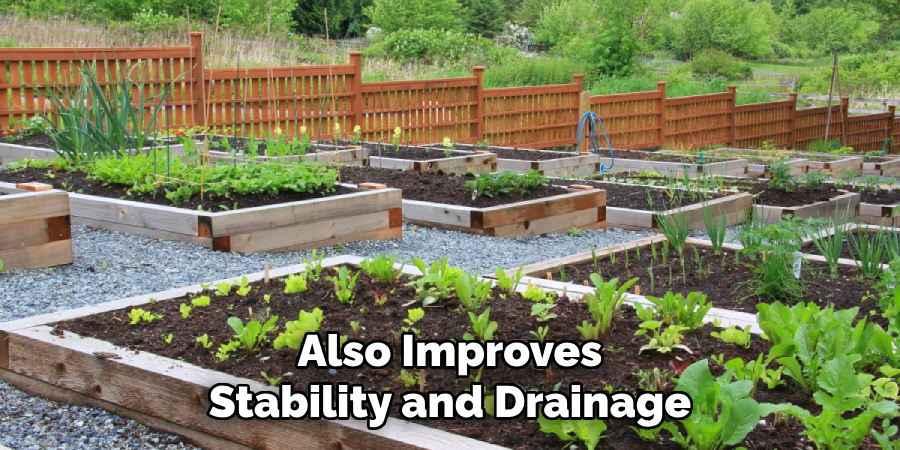
Insert Landscape Fabric Between The Soil And Stone Layers
To enhance stability in your stone flower bed and prevent soil erosion, consider using landscape fabric. Here are the key points to keep in mind:
- Prepare the soil: Before installing the landscape fabric, ensure that the slope is clear of any debris or vegetation. Level the area as much as possible to facilitate an even installation.
- Cut the fabric: Measure the dimensions of the flower bed and cut the landscape fabric accordingly. Make sure it covers the entire sloped area where the stones will be placed.
- Lay the fabric: Start at the bottom of the slope and unroll the landscape fabric upward. Secure it in place using landscape fabric pins or staples, ensuring it is taut and covers the entire surface.
- Cut openings for plants: If you plan to plant directly into the soil, make small incisions in the fabric where each plant will be inserted. This allows for proper growth while still maintaining the fabric’s stability.
Add Soil Amendments To Improve Drainage And Fertility
To promote healthy plant growth and prevent water accumulation, it is essential to improve the soil’s drainage and fertility. Consider the following points:
- Assess the soil: Prior to adding any amendments, test the soil on your slope to determine its composition and nutrient levels. This will help you identify the specific needs of your plants.
- Organic matter: Incorporate organic matter, such as compost or aged manure, into the soil. This improves its structure and nutrient content while aiding in drainage.
- Sand or gravel: If your soil has poor drainage, adding sand or gravel can help enhance water flow and prevent waterlogged conditions.
- Vermiculite or perlite: For heavy clay soils, vermiculite or perlite can be added to increase drainage and loosen the soil structure.
- Balance ph levels: Some plants prefer acidic or alkaline soil. Adjust the ph levels accordingly using appropriate amendments to create an ideal growing environment.
By following these steps, you can ensure that your stone flower bed on a slope not only looks visually appealing but also remains stable and provides adequate drainage for plant growth. Remember to plan your project carefully and consider the specific needs of your plants to create a successful and thriving garden space.
Planting And Caring For The Flower Bed
Once you have prepared the slope and built your stone flower bed, it’s time to focus on the most important aspect of gardening – planting and caring for your flowers or shrubs. Follow these key steps to ensure a thriving and beautiful flower bed on your slope:
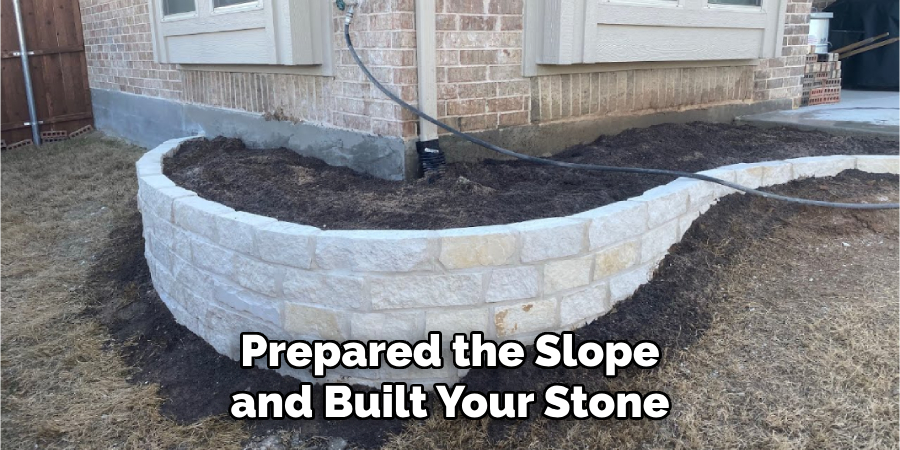
Choose Plants That Can Thrive In A Sloped Environment
When selecting plants for your stone flower bed on a slope, it’s essential to choose varieties that can handle the unique challenges posed by the incline. Look for plants that have strong root systems to anchor them in the soil and thrive despite the potential erosion.
Additionally, consider plants that are drought-tolerant as the slope can cause water to run off more quickly, potentially leading to reduced moisture levels.
: begin by researching suitable plant options for your specific climate and slope conditions.
: look for plants with deep and extensive root systems to help stabilize the soil and prevent erosion.
: consider drought-tolerant plants that can withstand periods of reduced moisture levels.
Dig Holes And Plant The Selected Flowers Or Shrubs
Proper planting techniques are crucial when establishing a flower bed on a slope. Follow these steps to ensure successful growth and establishment of your chosen plants:
: dig holes that are wide and deep enough to accommodate the root systems of your selected plants.
: place the plants in the holes, ensuring they are at the same depth they were in their nursery containers.
: backfill the holes with soil, gently firming it around the plants.
: water the newly planted flowers or shrubs to help settle the soil and provide essential hydration for their establishment.
Mulch The Bed To Conserve Moisture And Suppress Weeds
Mulching is an important step in maintaining a healthy flower bed on a slope. Here’s why mulching is beneficial and how to do it correctly:
: spread a layer of organic mulch, such as wood chips or shredded bark, around your plants.
: mulch helps retain moisture in the soil, reducing water runoff and keeping the plants hydrated.
: additionally, mulch acts as a natural weed suppressant, minimizing the competition for nutrients and reducing the need for frequent weeding.
: make sure not to mulch directly against the stems or trunks of plants, as it can cause root rot.
Water And Fertilize Regularly, Considering The Slope’S Impact On Watering
Watering and fertilizing practices need to be adjusted to accommodate the unique needs of a sloped flower bed. Follow these guidelines for optimal plant health:
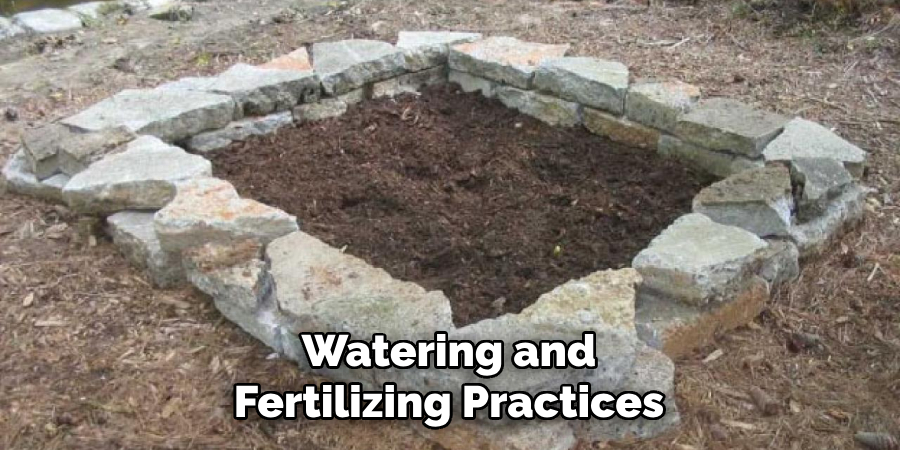
: water the flower bed regularly, paying attention to the slope’s impact on water distribution. The incline may cause water to flow more quickly, requiring more frequent watering to ensure proper hydration of the plants.
: monitor the moisture levels in the soil by checking it regularly. Water when the top two inches of soil feel dry to the touch.
: use a slow-release fertilizer or organic compost to provide essential nutrients to your plants. Apply according to the manufacturer’s instructions for best results.
: consider using a liquid fertilizer formulated for flowering plants during the growing season to boost their blooming potential.
By carefully selecting suitable plants, correct planting techniques, proper mulching, and regular watering and fertilizing, your stone flower bed on a slope will flourish with an array of vibrant colors and beautiful blooms. Enjoy the fruits of your labor and the visual appeal it adds to your landscape.
Happy gardening!
Maintaining The Stone Flower Bed
After successfully building a stone flower bed on a slope, it’s important to provide regular maintenance to ensure its longevity and beauty. Follow these key points to keep your stone flower bed in excellent condition:
Trim And Prune Plants As Needed To Maintain Shape And Size
- Regularly assess the plants in your stone flower bed to determine if any pruning or trimming is required.
- Use pruning shears or hedge trimmers to remove any overgrown or dead branches.
- Aim to maintain the desired shape and size of the plants within the flower bed.
- Trim back any plants that may be encroaching on neighboring stones or other plants.
Replace Mulch As Necessary To Control Weeds And Retain Moisture
- Periodically inspect the mulch in your stone flower bed and replenish it as needed.
- Mulch helps to suppress weeds, retain moisture in the soil, and provide insulation to the plants.
- If you notice any bare spots or areas where the mulch has thinned out, apply a fresh layer of mulch.
- Choose a suitable mulch material such as wood chips, shredded bark, or compost.
Inspect For Erosion Or Shifting Stones And Make Necessary Repairs
- Regularly inspect your stone flower bed for signs of erosion or shifting stones.
- If you notice any stones that have shifted out of place, carefully reposition them to ensure stability.
- Look for any gaps or voids between the stones and fill them in with additional soil or small stones.
- Address any erosion issues by adding soil or installing erosion control measures like retaining walls or stepping stones.
Maintain Proper Watering And Fertilization Routine
- Establish a watering routine that suits the specific needs of the plants in your stone flower bed.
- Monitor the moisture level of the soil and water accordingly, ensuring neither overwatering nor underwatering.
- Consider using a drip irrigation system to provide consistent and efficient watering.
- Regularly fertilize the plants in your flower bed to promote healthy growth and vibrant blooms.
- Choose a suitable plant fertilizer and follow the manufacturer’s instructions for application.
By following these maintenance practices, you can keep your stone flower bed looking its best throughout the seasons. Regular trimming, mulching, inspecting for erosion, and providing proper watering and fertilization will contribute to the long-term health and beauty of your stone flower bed.

So roll up your sleeves and get ready to enjoy the rewards of a well-maintained stone flower bed on your slope!
Frequently Asked Questions For How To Build A Stone Flower Bed On A Slope
How Do You Build A Stone Flower Bed On A Slope?
To build a stone flower bed on a slope, start by digging a level trench at the base of the slope. Place the biggest stones in the trench as a stable foundation. Gradually build up the wall using smaller stones, making sure to backfill behind each layer to prevent soil erosion.
Finish off with a layer of topsoil and plant your flowers.
What Are The Benefits Of Building A Stone Flower Bed On A Slope?
Building a stone flower bed on a slope not only adds beauty to your landscape but also provides several benefits. It helps prevent soil erosion, creates a natural drainage system, and adds depth and texture to the garden. Additionally, it allows you to grow a wider variety of plants, as some flowers thrive on slopes due to better drainage and sun exposure.
What Tools And Materials Are Needed To Build A Stone Flower Bed On A Slope?
To build a stone flower bed on a slope, you’ll need a few essential tools and materials. These include a shovel, wheelbarrow, level, measuring tape, gloves, safety goggles, gravel or sand for the foundation, a variety of stones (preferably flat and sturdy), topsoil, and of course, the flowers or plants of your choice.
Can I Build A Stone Flower Bed On A Steep Slope?
While it’s possible to build a stone flower bed on a steep slope, it requires additional care and planning. Ensure proper drainage to prevent water runoff, pick stones that are stable, and create terracing or steps for easier access and maintenance.
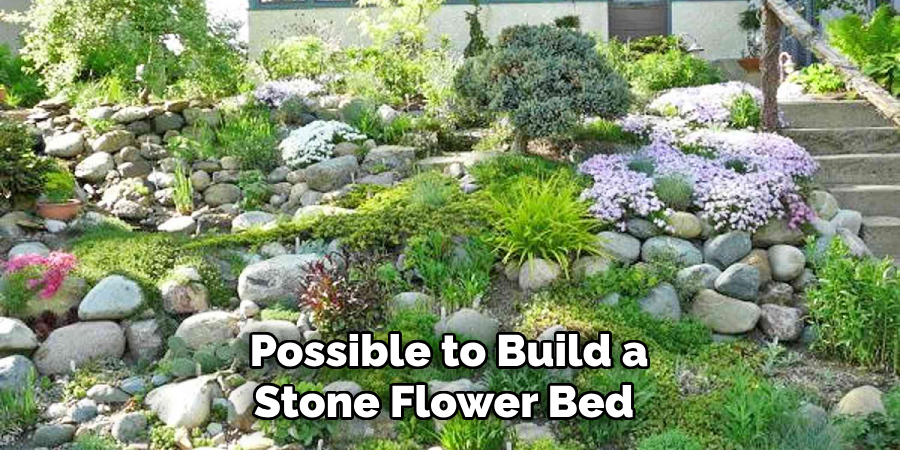
Consulting a landscaping professional can also ensure a successful project on a steep slope.
Conclusion
Building a stone flower bed on a slope can be a challenging but rewarding project. By following the necessary steps and taking your time to plan and prepare, you can create a beautiful and functional addition to your garden. Start by choosing the right location and materials for your project.
Clear the area and create a solid foundation using a retaining wall or terrace. Carefully arrange and secure the stones, ensuring they are level and secure. Finally, add soil and plants to complete your stone flower bed. With proper maintenance and care, your flower bed will thrive and add value to your outdoor space.
Remember to regularly check for erosion and make any necessary repairs. With patience and persistence, you’ll soon have a stunning stone flower bed that enhances the aesthetic appeal of your slope and brings joy to your gardening experience.

